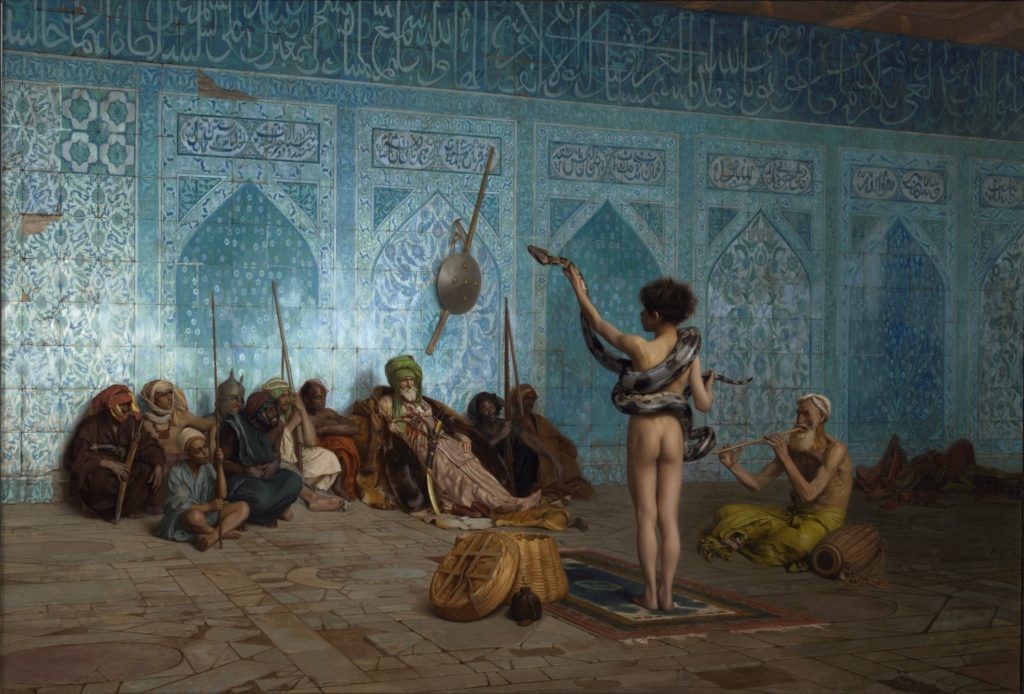Videos of the ‘Objects of Orientalism’ symposium are available on the Clark Art Institute’s YouTube Channel.
On April 29th and 30th 2016, a symposium at the Clark entitled “Objects of Orientalism” – convened by Marc Gotlieb and Mary Roberts, and supported in part by the Williams Graduate Program in the History of Art – offered an opportunity to reassess the significance and utility of “Orientalism” as an interpretive model and artistic practice, given that scholarship in recent years has highlighted transcultural exchanges, reciprocal intellectual curiosity and global histories of art. Focused at the juncture between Islamic art and European art in the second half of the nineteenth century but also touching on earlier periods, the symposium addressed a variety of issues around the temporal and geographical specificity of Orientalist artworks, demonstrating new approaches to examining objects across various media.
Since the 1978 publication of Edward Said’s Orientalism, scholars have debated the asymmetry that Said articulates between the Occidental wielder of power and the Oriental “other,” a reductive vision that fails to acknowledge the complex dynamics and fruitful exchanges that emerged through cross-cultural interaction. Said makes a further distinction between the West’s ambivalent engagement with the East during the eighteenth century—referred to as a “free-floating” and flexible conception of the Orient—and the view advocated by nineteenth-century academic Orientalists, who emphasized ethnographic classification and hierarchy.[1] Historians of Orientalist art, then, must examine ways in which scholarship may have assumed an equally reductive view, overlooking ambiguities and accentuating imbalances of power and difference.
Indeed, many issues around Orientalist objects merit further consideration. What are art historians to make of those Eastern artists like Osman Hamdi Bey who represented their own cultures through an Orientalizing lens? If Orientalist artworks are as problematic as some believe, why would they find such warm reception in the Middle East as embodiments of cultural patrimony? What are the curatorial strategies for and ramifications of bringing together “Oriental” and Orientalist objects? How has an emphasis on the exotic and the erotic prevented us from recognizing more nuanced undercurrents in Orientalist artistic practice? These and other issues were discussed at the symposium, broadening the definition of Orientalism and finding ways to incorporate new approaches to the field.
Edhem Eldem, Luke Gartlan, Mary Roberts, and Ünver Rüstem presented on topics related to Ottoman culture, with Roberts introducing collecting and display to the discussion with a look at the richly decorated living room of William Henry Wrench, British Vice Consul in Istanbul between 1872 and 1896. Filled with hundreds of art objects, the room collapsed temporal and geographical space by installing Oriental objects within a distinctly Orientalist interior, curated by a British collector in his Istanbul home. The interior, Roberts argued, became “a space of transformation” in which Oriental antiquities were folded into Orientalist principles of display as well as Ottoman modernity. The viewer thus encountered a layered Orientalism, with elements that must be distinguished from each other.
Zirwat Chowdhury and Tim Barringer addressed issues related to South Asia. Focusing on a panorama by William Daniell, an English painter who traveled across India during the late eighteenth century, Chowdhury’s presentation drew connections between the coercion of elephants to subdue them into labor (the theme of Daniell’s work) and imperial assertions of power over natives in the guise of consent or persuasion. Barringer demonstrated ways in which hybrid musical compositions such as Sophia Plowden’s Hindustani Air 9 (1786) brought together Indian and British musical traditions, histories, and cultures. Barringer also explored how sound, volume, and rhythm were manipulated to communicate the solidity of empire, particularly at the Delhi Durbars where sound became a unifying language that expressed the triumph and permanence of British imperial rule.

Jean-Léon_Gérôme, The Snake Charmer, c. 1879. Clark Art Institute, Williamstown. Image: Wikimedia Commons.
The conference also featured a gallery session with several works from the Clark’s impressive collection of Orientalist paintings, including John Singer Sargent’s Fumée d’Ambre Gris (1880) and Jean-Léon Gérôme’s The Snake Charmer (c. 1879) (Fig. 1). The presence of this now infamous painting on the cover of Said’s book catapulted its naked subject from obscurity to stardom as the embodiment of the exoticized, eroticized Orient. A closer look, however, suggests how viewing The Snake Charmer solely through an Orientalist lens may have obscured other issues present in the work. More specifically, by presuming and focusing on the painting’s theme of Eastern homoeroticism, scholars have, in my opinion, neglected to note an element of sexual ambiguity present in the painting and in other (non-Orientalist) examples of late nineteenth-century European art. As elucidated in Alison Syme’s A Touch of Blossom: John Singer Sargent and the Queer Flora of Fin-de- Siècle Art (Penn State University Press, 2010), this was an era in which numerous artists engaged with uncomfortable and ambivalent sexuality, and by comparing The Snake Charmer’s youth to Sargent’s contemporaneous representations of Rosina Ferrara, we might recognize that the face and body of Gérôme’s eponymous subject is similarly ambiguous. Perhaps an approach to Orientalist visual culture that allows for sexual ambivalence rather than insisting on either heterosexual or homoerotic narratives could lead to new insights.
Ultimately the greatest contribution of the “Objects of Orientalism” symposium was to highlight the many subtle ambiguities that pervade Orientalist visual practice, and to suggest how many of these artworks reveal a coming together of East and West rather than a differentiation or hierarchy between the two. Indeed, a more flexible approach to the study of European Orientalism needs to acknowledge the simultaneous allure and aversion to the Orient in the past, and its polysemous reception today.
Siddhartha V. Shah is a doctoral candidate at Columbia University, NY, specializing in South Asian and nineteenth-century European art
[1] Edward Said, Orientalism (New York: Vantage, 1978), 119.
Cite this note as: Siddhartha V. Shah, “Objects of Orientalism”, Journal18 (May 2016), https://www.journal18.org/685
Licence: CC BY-NC
